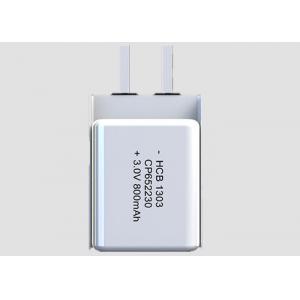
Add to Cart
No Passivation Lithium Primary Battery Aluminum Laminated Film Cellpacking
| Nominal Capacity | 800mAh |
| Battery discharged at continuous current 1mA until voltage reaches cut-off voltage 2.0V at ambient temperature 23±2℃ | |
| Nominal Voltage | 3.0 V |
| Maximum Continuous Current | 300mA |
| Battery with minimum 50% rated capacity discharged at ambient temperature 23±2℃ | |
| Maximum Pulse Discharge Current | 500mA |
| Battery with minimum 50% rated capacity discharged at max pulse for 3 seconds after 27seconds break. Ambient temperature 23±2℃ | |
| Storage Condition | Temperature ≤ 30℃ Humidity ≤ 75%RH |
| Operating Temperature | -40℃ to +60℃ |
| Battery Dimension | See drawing on pag |
| Max Weight | 7.0g |
| Self-discharge Rate | 2% |
| Max self-discharged rate at ambient temperature 23±2℃ | |
| Shelf Life | 10 years |
| Ambient temperature 23±2℃ | |
1. Battery Characteristic
The nominal voltage of single cell up to 3.0V
We provide the specific energy density up to 342Wh/kg, 50% higher than the steel-shelled lithium cell of the same weight
Battery working temperature range from -40℃ to +60℃
The battery self-discharge less than 2% per year at room temperature
There is no voltage passivation problem, also need not activated after long time storage, install-and-play, ultra-high maintenance-free features
To meet the requirements of modern light & handy electronic products
Dimensions can be customized according to different demands, short product development period, meeting customers’ varieties of personalized needs
The most reliable cell with the best safety performance; able to bear cruel tests without any protection such as short circuit, puncturing, etc.
2. Main Applications
Cardiac pacemaker, respirator, oxygenator, inspection devices, monitoring devices, infusion pump, etc.
Smoke detectors, security alarms, seismometers, locking system, monitoring system, etc.
RFID products, road toll transponder, IC cards, etc.
3. Manufacturing Advantages
4. Company Advantages
5. FAQS of General Safety Instructions
The battery should be stopped to using when the abnormal heat release or leakage occurs.
The manual is necessary to read before you would like to use the battery.
When you put the battery into the devices, you need to follow the signs + and -. If they are put in the wrong way, they are going to be hot in very short time and it will lead the leakage of gas and toxic materials which may cause a big rupture.
The batteries are able to be deformed or drilled into or damaged because the toxic materials or gas leakage may lead a big rupture.
When changing batteries be aware that batteries of different electrochemical system, grades, or brands should be not mixed. If different batteries are used or in case of using old and new batteries together this can discharge batteries due to different voltage or capacity. This can cause toxic material or gas leakage and/or violent rupture.
The batteries can’t be soldered directly. If they are directly soldered, it will cause short circuit and a gas and toxic material leakage or big rupture.
You can’t charge the primary batteries as it would lead to gas or toxic material leakage.
